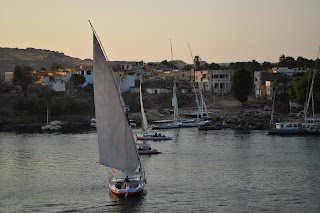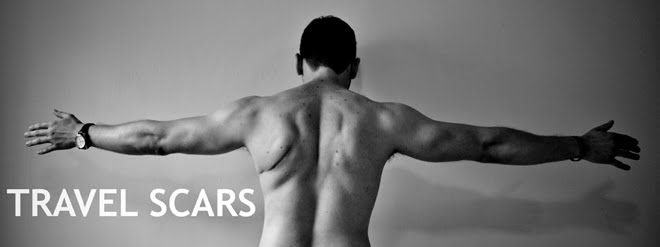Nov. 25th - 27th
As we left the ship, we were directed to the "Arrival Hole"(no joke!), and swiftly made our way through inspections. As we were walking through the winding corridors, we saw Ahmed being interrogated by some Egyptian soldiers. We continued to the train station and expected Ahmed to be released within minutes. After waiting for some time, we figured we'd just meet him in Aswan instead. Martin had already jumped ahead and planned on taking the train, but the next departure was only in a few hours, so Chris, Robert, Martin and myself, therefore decided we would just split a cab and check-in to a hotel.
Robert had already visited Egypt on several occasions and was very familiar with Aswan and the expected costs for pretty much everything. We soon got a taxi driver to agree to a fair price and he quickly sped down the highway towards central Aswan. We got out of the cab near a Robert-recommended guest-house. My immediate reaction to Aswan was one of astonishment to these unfamiliar surroundings: there were all these camera-toting, khaki-shorts wearing people everywhere. Could it be? Tourists? Coming from the Sudan, an overabundance of tourists felt quite foreign to me, but after so long on the road, I almost welcomed it. Almost.
Aswan is essentially centered by a tourist-infested Souq, or market, with bright lights, over-priced food and drinks; and souvenir shops galore. Making our way along this Souq, we were constantly bombarded by propositions to sell us pretty much every conceivable souvenir. We kindly said "no thank you" or "la shukran" and continued on towards the hotel. Once in the hotel, Martin, Chris and myself would share one room; while, Robert, Jens and Rene would share another.
Both Martin and Robert had some of their own plans, so Chris and I decided we would do some leisurely exploring. Due to the blaring heat, we didn't stray too far from the souq and spent the majority of our time sitting on various benches, commenting on how weird it is to see so many white people. Eventually, Chris and I met up with Ahmed, who we just bumped into in the streets and he said that he had been held at the arrival hole for 5 hours! I can understand a shady foreigner or Sudanese coming into Egypt being interrogated this way, but a young Egyptian?
That night, the seven of us went out for dinner. We made sure to find the only restaurant with no foreigners in it and had a great meal for a fair price. After our meal, we decided to grab a beer, which even in the tourist-laden country of Egypt, is not as easy as you might think. We finally ended up in a hotel bar where the rest of the clientele were middle-aged to older Egyptian men, reeking of stale cigarettes; sitting by themselves and slowly pouring their beers into an accompanying glass, one ounce at a time, drinking each shot down before pouring another. We were soon all pretty exhausted, and after two beers, we decided to call it a night.
Besides the souq, Aswan is renowned for it's corniche, or main road which follows this impressive stretch of the Nile. To contrast Egypt to Sudan: in Sudan, even when you are in a city, there is no doubt that you are still in the desert. In Aswan, despite the fact that across the Nile are immense sand-dunes and ancient ruins; a stroll around the city, with it's paved roads and sidewalks; and buildings constructed with crazy materials like brick and cement, you would be hard-pressed to imagine that you were anywhere but a westernized city.

This particular portion of the Nile is stunning, probably the nicest portion along it's 6650 km length. There are countless scenic lookout points and benches to sit and gaze at the river which is responsible for the prosperity and longevity of two such enduring civilizations (Egyptian and Nubian, who still forms a large population in southern Egypt). It would be an extremely peaceful experience if only you weren't continually pestered to take a goddamn felucca ride every 2-seconds! A felucca is a small sailing ship, and there are scores of them in Aswan. And for every boat, there are at least 5 felucca touters trying to get you to take a ride on theirs.

Chris and I eventually caught on to a method of avoiding a long and arduous dead-end negotiating session, by simply remembering where the felucca would be taking us and stating we had already been, and how beautiful it was. It worked surprisingly well.

We still needed a break from the touters and decided that the desert located on the other side of the Nile seemed like a good place to escape to. We took the local ferry across and were soon faced with the aforementioned sand-dunes and ancient monuments.

These impressive structures were tombs of Nobles, but had a measly admission price that Chris and I still did not feel like spending since our next destination was to Luxor, with it's incomparable Karnak temple and Valley of the Kings. Instead, we decided to walk through the desert to a "nearby" monastery. After 20-30 minutes of walking on dunes, and talking to a man that said the building we were looking for was 3 to 5 kilometers from our current position, we decided it was not worth the effort. Instead, I was going to climb up towards the tombs to take some pictures of Aswan. Chris, however, was going to wait for me at the bottom.


In addition to it's beautiful nautical landscape, Aswan also has another main draw: it being the closest major city to the magnificent temples of Abu Simbel. The temples of Abu Simbel are located 230 km southwest of Aswan and are actually only 40 kilometers from Wadi Halfa in Sudan, but due to the impossibility of public transportation between Sudan and Egypt (other than the ferry), you need to backtrack in order to see these impressive monuments.
Despite the fact that you need to get there in a police-escorted bus convoy, wake up and leave before 4 am; and we were accompanied by a couple from rural Ontario, who for the first time, made me ashamed to be associated with them as Canadians; and a supposed human-trafficker from the Ukraine who has been traveling for 6 years "without working"; it was still absolutely worth it!

Because we had travelled by convoy, our usual stay-as-long-as-we-feel attitude was forgotten and my race-to-see-every-conceivable-nook-and-cranny-in-the-shortest-time-possible approach took over. We were only given an hour or so to explore, so time was of the essence. We nevertheless had ample time to explore both temples rather thoroughly, and even find a good vantage point to snap some awesome shots of these immense shrines.

The two temples, that of Ramesses II (the Great Temple) and Nefertari (the Small Temple) are located only 100-meters apart and were completed in 1224 B.C. Guarding the entrance to the Great Temple, are four 20-meter (65-foot) statues of Ramesses II.



The Small Temple showcases two 10-meter (33-foot) statues of Nefertari near it's entrance, and not to be outdone, four more statues of Ramesses II in case someone forgot who was responsible for building these amazing temples. Despite lacking the gender-equality we are used to in our society, this is the only example in all of Ancient Egypt, where a statue of a Pharaoh and his Queen are the same size! Hey, it's a start!


Adorning the interiors of these two shrines are incredibly intricate hieroglyphs detailing every conceivable aspect of Ramesses' exploits in battle, and providing offerings to various deities. Unfortunately, I do not have any pictures from inside either temple because I actually respected the 'No Photos in the Temple' signs, despite the innumerable amount of tourists taking "subtle" snaps as they walked around these expansive structures.

One final note on these temples. It is hard not to be impressed by the colossal statues and delicately detailed interiors, however, the fact they are still intact at all is an achievement all by itself. The temples of Abu Simbel were originally built in an area now flooded by Lake Nasser. With the impending construction of the Aswan High Damn and rising waters in Nubia, the survival of Abu Simbel was of utmost importance. An international team of archaeologists therefore devised a plan to cut the temple into smaller blocks, transport them to higher ground, and then meticulously reassemble the monuments. Believe it or not, these temples were painstakingly moved 65 meters higher and 200 meters back from the shores of the Nile. Pretty astonishing if you ask me.

Upon our return to Aswan, our friends were already planning their next course of action. Martin had booked an overnight bus-ride to Cairo, which was leaving very shortly.
Rene still had to await the arrival of his truck from the vehicle-ferry, Jens was still planning to rest a few days before continuing his ride towards Cairo, and Ahmed would be going directly to Alexandria. Robert would be heading to Luxor that evening, and Chris and I, content with our stay in Aswan, decided that we would follow our Czech friend to the world-famous city, with it's many temples and countless tombs. Did I mention that Robert had once dreamed of being an egyptologist and could therefore vividly recount the entire history of Egypt, it's temples and tombs with stunning accuracy and zeal? No? Well he could. Chris and I were in for a real treat!



